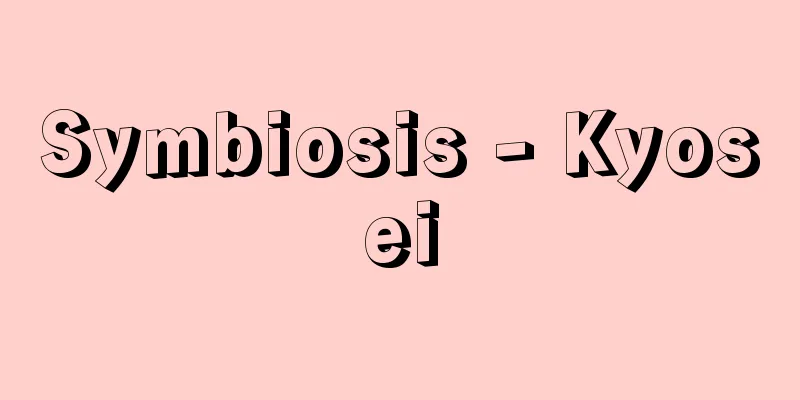Symbiosis - Kyosei

|
A phenomenon in which different kinds of organisms live together while maintaining a close physiological or ecological bond. In principle, symbiosis refers to a relationship between individuals, but it can also include relationships between groups such as societies and populations, and its scope is unclear. Symbiosis is not when two organisms simply live in the same habitat or when they indirectly affect each other through a third organism. Symbiosis in which both symbiotic partners benefit in their lives is called mutualism, symbiosis in which only one partner benefits and the other receives neither benefit nor disadvantage is called commensalism, and symbiosis in which one partner benefits and the other suffers a disadvantage is called parasitism. However, the criteria for determining benefits and disadvantages are not always clear and are often expedient and intuitive. There is also a view that distinguishes parasitism from symbiosis and uses the two as antonyms. Symbiosis in which the existence of the other is essential for one's survival is called obligatory symbiosis, and in which it is not essential is called optional symbiosis. Lichens are closely interdependent communities of algae and fungi, and are usually treated as separate taxa. They are found on bare rocks and in extremely cold regions, where neither can survive on their own. The algae provide the fungi with carbohydrates obtained through photosynthesis, and the fungi provide them with water and minerals. Flagellates that live in the intestines of termites provide them with nutrients by breaking down the cellulose in wood particles that the termites cannot digest, while the flagellates obtain food and a place to live. This relationship is called digestive symbiosis. Zooxanthellae that live symbiotically in the bodies of coral polyps play an important role in removing waste products from the coral and forming its skeleton. In mutually beneficial symbiosis between animals, signaling systems are often developed between the two. When an ant lightly taps an aphid with its antennae, the aphid secretes a sugary substance. Gobies that live in the burrows dug by pistol shrimp keep watch at the entrance and vibrate their tails to warn the shrimp when danger approaches. Oxpeckers remove mites and parasites buried under the skin of warthogs and use them as food. Additionally, the clean wrasse and thrush shrimp that live on coral reefs eat parasites and damaged skin that attach to the surface of fish bodies and gills. These types of relationships are called cleaning symbiosis. In commensalism, as in parasitism, there are often extreme differences in body size between the host and symbiont, such as barnacles that grow on the skin of whales and on the shells of turtles, clownfish that live in the cloaca of sea cucumbers, and clownfish that hide in the tentacles and mouth passages of sea anemones. Most living things, both animals and plants, form symbiotic relationships with other living things. Symbiotic relationships are one of the most basic interspecies relationships, along with predator-prey relationships and competitive relationships. [Yasunagasawa Yasunobu] The cleaner fish, the cleaner wrasse, enters and exits the mouths of larger fishes to remove parasites and leftover food, while protecting itself from predators. © Underwater Fort Enterprise, Isamu Soyama "> Symbiosis between the Cleaner Wrasse and the Grouper (Ecology) Source: Shogakukan Encyclopedia Nipponica About Encyclopedia Nipponica Information | Legend |
|
異なる種類の生物が、生理的あるいは生態的に緊密な結び付きを保ちながらいっしょに生活している現象。共生は原則的には個体間の関係をさすが、社会や個体群など集団の間の関係を含める場合もあり、その適用範囲はあいまいである。2種類の生物が単に同じ生息場所にすんでいる場合や、第三の生物を介して間接的に影響しあっている場合は共生とはいわない。 共生者の双方が生活上の利益を受ける共生を相利共生、一方のみが利益を受け他方が利益も不利益も受けない共生を片利共生、一方が利益を受け他方が不利益を受ける共生を寄生という。しかし、利益・不利益の判断基準はかならずしも明確ではなく、しばしば便宜的、直観的である。寄生を共生から区別し、両者を対語として用いる見解もある。相手の存在が自分の生存に必須(ひっす)である場合を義務的な共生、必須でない場合を任意的な共生という。 地衣類は藻類と菌類とが緊密に相互依存してできた共同体で、普通、独立した分類群として扱われる。それぞれ単独では生息できない裸岩上や極寒地にまで分布する。藻類は光合成によって得た炭水化物を菌類に供給し、菌類からは水と無機物を得ている。シロアリの腸管にすむ鞭毛虫(べんもうちゅう)類は、シロアリが消化できない木材細片中のセルロースを分解して栄養源を供給し、一方、鞭毛虫類は食物と生活場所を得ている。この関係を消化共生という。サンゴのポリプの体内に共生する褐虫藻は、サンゴの排出物の除去と骨格の形成に重要な役割を果たしている。 動物どうしの相利共生では、双方の間にしばしば信号系が発達している。アリが触角でアリマキを軽くたたくと、アリマキは糖分を含んだ分泌物を出す。テッポウエビが掘った巣穴に同居するハゼは入口で見張りをし、危険が近づくと尾部をふるわせてエビに知らせる。ウシツツキはイボイノシシの体表に埋まっているダニや寄生虫を取り除き、それを自分の餌(えさ)とする。また、サンゴ礁にすむホンソメワケベラやオトヒメエビは魚の体表やえらに付着する寄生虫や悪くなった皮膚を食べる。これらの関係を掃除共生という。 片利共生では、寄生と同様、宿主と共生者の間に極端な体の大小があることが多い。クジラの皮膚やカメの甲に着生するフジツボ、ナマコの排出腔(はいしゅつこう)にすむカクレウオ、イソギンチャクの触手や口道に隠れるクマノミなどがその例である。 動物・植物を問わず、大部分の生物は他のいずれかの生物と共生関係を結んでいる。共生関係は、捕食と被食関係、競争関係とともにもっとも基本的な種間関係の一つである。 [柳沢康信] 掃除魚のホンソメワケベラは、大形魚の口内に出入りして寄生虫や残餌をとる一方、自らは外敵から保護される©水中フォート・エンタープライズ 楚山いさむ"> ホンソメワケベラとクエの共生(生態) 出典 小学館 日本大百科全書(ニッポニカ)日本大百科全書(ニッポニカ)について 情報 | 凡例 |
Recommend
vin mousseux (English spelling) vin mousseux
…Effervescent wine is called sparkling wine in En...
Rescue method - information
…The first, third, and fifth characters should ha...
Tisa
The Danube is the largest river in Hungary, with ...
Mihama [town] - Mihama
A town in Minamimuro County in the southern part o...
Curved surface
From the standpoint of analysis, surfaces such as...
Asahikawa City Former Aborigine Protection Land Disposal Law - Asahikawa City Former Aborigine Protection Land Disposal Law
...Based on this adoption, in July of the same ye...
Oobil - Obiru
…A perennial plant of the lily family (illustrati...
hypacidity
...A healthy adult secretes 1 to 1.5 liters of ga...
GOD
...Famous examples of systems building include th...
Osaka Alkali Incident
...Of the court cases in which compensation for d...
Suijin - Suijin
A legendary emperor from ancient China. One of th...
Self-restraint - Self-restraint
In socialist countries, the public actors in agri...
diverticulum
...Chronic enteritis refers to a condition that c...
Random error
Random errors without bias. Source: Asakura Publis...
Pardon power - onsha taiken
...Supreme Command), (7) Prerogative of Military ...









